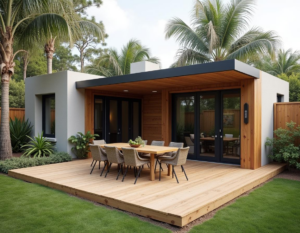Adding an Accessory Dwelling Unit (ADU) to your property in Florida can be a transformative and practical decision. Whether you’re planning a backyard cottage or converting existing space, understanding the key aspects of building an ADU is crucial. In this comprehensive guide, we’ll explore the essential things you need to know before embarking on your ADU construction journey in the Sunshine State.
- Check Local Zoning Regulations: Before diving into ADU construction plans, familiarize yourself with local zoning regulations. Each municipality may have specific rules regarding ADUs, including size restrictions, setback requirements, and allowable locations. Check with your local planning department to ensure your plans align with zoning codes.
- Types of ADUs: Florida allows various types of ADUs, including detached structures, attached additions, and garage conversions. Understand the different types and choose the one that best suits your property and needs.
- Permitting Process: Obtaining the necessary permits is a crucial step in ADU construction. The permitting process involves submitting detailed plans to the local building department for review. Be prepared to provide information on the structure’s design, utilities, and compliance with building codes.
- Impact Fees and Development Costs: Check with local authorities for any impact fees or development costs associated with building an ADU. Some municipalities may have fees to cover the impact of increased population density on public services.
- Utilities and Connections: Ensure your ADU plans include provisions for utilities such as water, electricity, and sewage. Check with utility providers to understand the requirements and costs associated with connecting your ADU to existing infrastructure.
- Design Considerations: Work with an architect or designer to create detailed plans for your ADU. Consider factors such as the layout, aesthetics, and functionality. Keep in mind that the design should comply with building codes and zoning regulations.
- Accessibility Requirements: Be aware of accessibility requirements, especially if you plan to rent out your ADU. Consider features such as ramps, wider doorways, and accessible bathrooms to accommodate all potential occupants.
- Budgeting and Financing: Develop a realistic budget for your ADU project, taking into account construction costs, permits, design fees, and any unexpected expenses. Explore financing options such as loans, grants, or personal savings to fund your project.
- Construction Timeline: Understand the construction timeline for your ADU. Factors such as weather, availability of materials, and contractor schedules can impact the timeline. Plan accordingly and communicate with your construction team to set realistic expectations.
- Renting Out Your ADU: If you plan to use your ADU as a rental property, familiarize yourself with landlord-tenant laws in Florida. Consider rental agreements, screening tenants, and potential income as part of your overall ADU plan.
Conclusion: Building an ADU in Florida requires careful planning, adherence to regulations, and consideration of various factors. By staying informed about local requirements, budgeting effectively, and collaborating with professionals, you can successfully navigate the process and create a valuable addition to your property. Remember to stay updated on any changes to building codes and regulations to ensure a smooth ADU construction experience.






